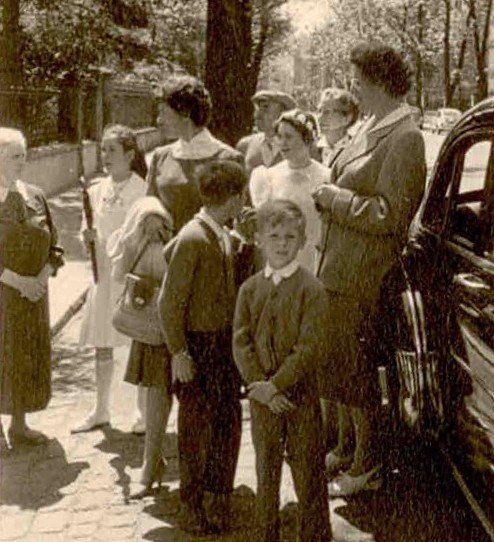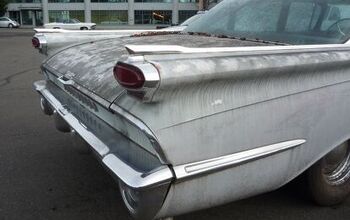Curbside Classic Review: 1951 Oldsmobile Super 88

No one’s going to accuse me of not having a nostalgic streak, especially when it comes to cars. That’s what motivated me to write the Auto-biography, my time travel through words. How about the real thing, in steel, glass, rubber and wool? One of my main motivations for starting Curbside Classics was to document and re-experience the cars from those early years, and few were as influential as the original Olds 88. Most of the time, the reliving is somewhat vicarious, but once in a while, I get lucky, and it’s the real thing. So let’s literally open the door to the past, and hop in for a ride with me in this beautiful 1951 Super 88. And if it gets a bit crowded, good; that’ll make it all the more authentic.
Exactly fifty years ago, a big black Olds 88 rolled up in front of our apartment building in Innsbruck, Austria. I was already waiting out front, eagerly anticipating the appearance of one of my favorite cars in town (I pretty much knew them all). Herr Miller’s Olds was THE taxi to hire for special family outings, thanks to its roominess compared to the Mercedes 180 Diesels it shared with the downtown taxi stand. Well, that was the parents’ reason; mine was because of its burbling Rocket V8.
It was my sister and my cousin’s Confirmation, so a family outing with sponsors, aunt, and Grandma to some now-forgotten destination in the Alps was on order. The total party was eleven; my parents are not in the picture. If it wasn’t obvious, that’s me in the front looking very anxious to get going.
Since we were car-less and normally walked everywhere, we were trim and somehow all fit into the Olds. I got the best seat in the house: on my aunt’s lap (she’s the giant in the picture), in the middle of the front seat, right up against Herr Miller. In my mind, as I looked through the wing fins of the rocket-ship hood ornament, I was driving the big yank tank, making that Rocket V8 purr as it effortlessly glided us up into the mountains.
Fast forward a half century, and now I really am sliding behind that big steering wheel thanks to TTAC reader Oregon Sage. He and his wife picked up this well cared-for Super 88 a while back, and offered its services to me. I was sorely tempted to round up nine other folks, to really re-create the Confirmation outing, but since my host wasn’t charging a fare, I decided that might be pushing things a bit, literally.
My first impression upon entering is that highly familiar and distinctive old car smell, the polar opposite of today’s polymeric factory air. Understandable too, as almost all the interior ingredients other than steel and glass are organic: wool fabrics on the seat, headliner and doors; horse-hair stuffing; and over half a century’s of boogers stuck under the seat. Between the odors they’ve absorbed and those created by their subtle decay, it’s a mélange that induces nostalgia, melancholy and the desire to crack one of the vent windows.
The 303 cubic inch V8 quickly springs to life after a burst from the chrome starter button on the dash. And while it warms its fluids for a minute or so, I had better talk about this ground-breaking engine, especially since I got (rightly) razzed for omitting any reference to it in my story on the ’50 hot-rod Caddy. Hey, I just got carried away by that awesome beast.
Contrary to its late-stage geriatric image, Oldsmobile once was the innovation division at GM (here’s my Olds bio). As such, it got the green light (along with Caddy) to develop the first new modern ohv V8 engines. It was a friendly sort of inter-divisional competition, and the Caddy appeared six months before the Olds, but both engines were big-time winners. Except for a couple of very minor teething issues, these engines quickly developed reputations for bulletproof reliability and longevity.
Originally, the plan was to only put the Rocket V8 in the big 98-series cars, but a late decision to drop it into the smaller and lighter 76-series created the legendary 1949 Futuramic 88, the first modern affordable muscle car. Of course, that title is highly relative, since with 135 horsepower, the early versions of the V8 weren’t exactly Rockets. With a stick-shift on a good day, it might scoot from 0-60 in about twelve seconds. But the competition all had pokey old-school sixes and straight eights, so the 88 was in a class of its own. It took a NASCAR title in ’49, and a class speed record at Daytona of 100.28 mph. And it inspired the rock and roll classic, penned by Ike Turner:
You may have heard of jalopies,
Have I given the Rocket its due props? Oh, I forgot; from its modest 303 cubic inch, 135 hp beginnings, its muscles swelled through the years to 455 cubes (7.4 liters) and 400 horsepower. And then terminal atrophy set in; by 1980 it was back to 307 cubes (5 liters) and 150 hp; by 1988, 140 hp. Circular development, or just old age?
I’d say we’ve duly warmed up this motor, so let’s drop her into gear. Now we have to give the Hydramatic equal time. That granddaddy of all automatics was developed in the thirties and first appeared on the 1940 Oldsmobile. It operates quite differently from its modern namesakes. Because it uses a fluid coupling, which doesn’t amplify torque like a torque converter, it needs plenty of gears, four of them actually. And they’re mighty anxious: with a gentle take-off, we were well into third before reaching the far side of a small downtown intersection.
The Hydramatic, with its busy and bumpy shifting, doesn’t really feel like a “slush box” at all, but more like the sequential auto-shifters today (the dumber ones, that is, like the Smart). Well, there’s a lot going on down there, especially in the 2-3 shift, which involves the simultaneous operation of two bands and two clutches. Synchronizing their dance perfectly was hard enough when new; after almost sixty years you have to cut them some slack.
But it’s an efficient box; in high gear, only 25% of the engine torque flows through the fluid coupling, so it feels directly coupled, like a stick shift, and very unlike the Buick’s Dynaflow propeller-in-a-bucket-of-water sensations. And contrary to some of GM’s later innovations, the original Hydramatic was a durable collection of gears, clutches, bands and tireless little gnomes that worked them all, right from the get-go.
These old tanks are perfect cars for tooling around on a quiet Sunday morning in Eugene, which probably best replicates the traffic conditions of Innsbruck back then. One feels more like a helmsman than a driver, as the giant steering wheel dominates the manual tasks at hand, thanks to the automatic. Ponderous and slow at first, the unassisted tiller lightens with speed, but only relatively so. Handling? It hadn’t been invented yet, at least not in Detroit. The tired springs and shocks don’t help either.
But the engine is responsive and distinctly feels like the most modern component in this car. If you dropped it into a 1988 Cutlass Supreme Classic Brougham Coupe (whew; what a mouthful) you’d probably never notice the difference from the 140 hp 307 in that. Or maybe you would; the ’51 303 probably has better throttle response.
These Rocket 88s are for the open road, and this one is still quite happy to purr along at seventy on the highway. That universally abused old Driver’s Ed invocation about keeping a car’s length distance for every ten miles per hour suddenly pops in my head, and for a good reason: old drum brakes. I can see that venerable graphic from the textbook in my mind’s eye, with the spaces laid out in front of the represented car, which I swear was an old Oldsmobile like this.
The Rocket 88’s influence is monumental, and not just from a hot-rodding perspective. Just like the ’32 Ford V8 spoiled Americans with a step up in everyday performance, so again did the 88. And the whole industry followed its lead; the 88 is the prototype of the quintessential American car: a responsive and torquey V8, automatic transmission, and room for…eleven skinny and car-starved Austrians. Most Americans quickly settled for nothing less. But what about places like Austria in the fifties?
In its time, cars like this Olds were living on an exulted plain in the Old Country. The choice of many affluent Europeans then, they were desirable and highly respected. A 30 hp VW was still a distant aspiration of the middle class. My father, a doctor, and all six of my aunts and uncles were still car-less when we emigrated in 1960. Within a few years, that all changed; all the aunts and uncles had wheels. And when I went back for the first time in 1969, Herr Miller was driving a new W114 Mercedes 200 diesel, with bucket seats. No six-year olds were going to be sidled up next to him in that taxi, making vivid memories worth writing about fifty years later.
Thanks to OregonSage for the memorable time behind the wheel of your Olds

More by Paul Niedermeyer
Latest Car Reviews
Read moreLatest Product Reviews
Read moreRecent Comments
- SCE to AUX They're spending billions on this venture, so I hope so.Investing during a lull in the EV market seems like a smart move - "buy low, sell high" and all that.Key for Honda will be achieving high efficiency in its EVs, something not everybody can do.
- ChristianWimmer It might be overpriced for most, but probably not for the affluent city-dwellers who these are targeted at - we have tons of them in Munich where I live so I “get it”. I just think these look so terribly cheap and weird from a design POV.
- NotMyCircusNotMyMonkeys so many people here fellating musks fat sack, or hodling the baggies for TSLA. which are you?
- Kwik_Shift_Pro4X Canadians are able to win?
- Doc423 More over-priced, unreliable garbage from Mini Cooper/BMW.















































Comments
Join the conversation
Thanks Paul for another good article. Ike and Tina Turner's "Rocket 88" is considered by many to be the birth of Rock and Roll.
Grandpa had a '54 Olds 98, pretty much the same car as this but with a bigger back seat and trunk. We kids loved it! This, despite the 0-guage clear plastic over the rear upholstery. You could play "army" or "cars" on the huge rear floor. The '58 Olds 98 he traded it on was bigger and chromier, but not roomier. And the lack of rear vents was felt back there, as, like the '54, it didn't have AC.